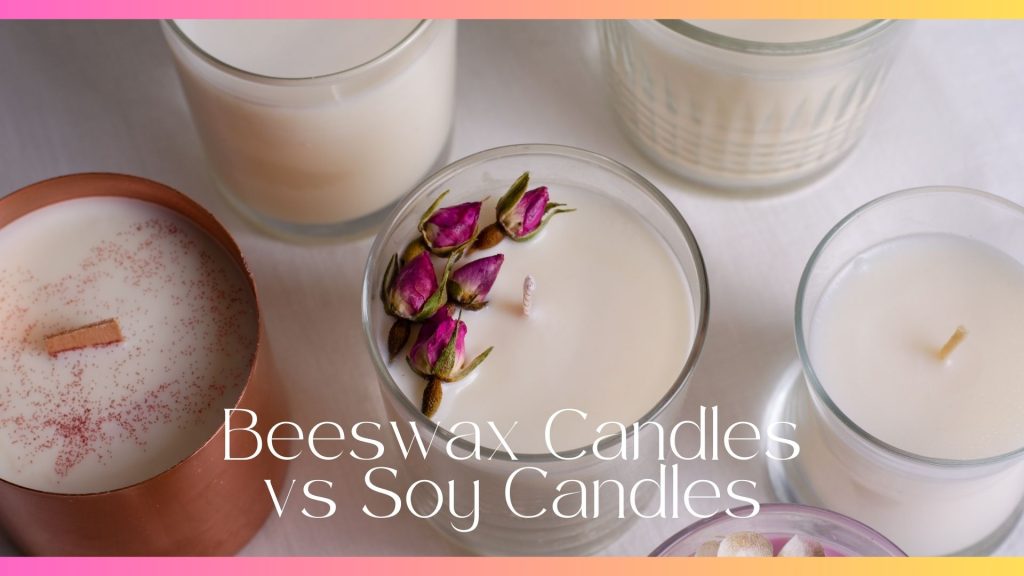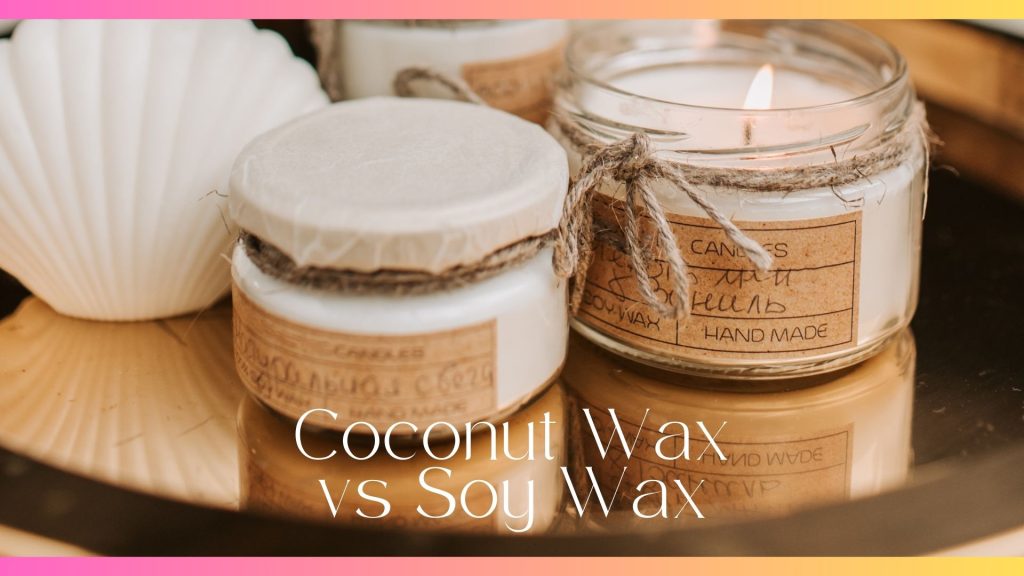Want to know how to make coconut candles at home? Here’s a simple guide for you to get started as a complete beginner!
While soy and paraffin candles have long been in the market, coconut candles is still pretty new and many don’t know how to handle them.
In this article, I’ll share more on how you can make your own coconut candles from home and materials you’ll need to get started.
Disclaimer: This post may contain affiliate links. This means I may earn a small commission (at no cost to you) if you sign up for a program or make a purchase using my link!
Related Posts:
- Soy Candles vs Coconut Candles for Candle-making
- How To Make Coconut Wax Candles with Essential Oils
- How To Compare Coconut Wax to Beeswax for Candle-making
Why Make Coconut Candles?
Coconut candles are growing in demand, thanks to their great eco-friendly properties. Aside from being a naturally renewable resource, coconut wax and coconut candles are biodegradable – meaning it can decompose pretty quick once disposed and won’t contribute to landfill waste.
It’s also highly preferred by candle makers as coconut wax holds fragrances well, better than soy wax and may be quite comparable to paraffin wax. The candle burns much cleaner compared to paraffin (not eco-friendly) and slower, making it possible for you to enjoy your scented candles for much longer.
A clean burn means lesser soot and smoke produced, which helps with preventing blackened walls or ceilings especially when used indoors in small areas. The scent throw of coconut wax is great when both hot or cold, meaning your candles will fill the room with fragrance, whether they’re lit or not.
How to Make Coconut Candles at Home
Gathering Your Supplies
- Coconut Wax: Get 100% pure coconut wax when making coconut candles as a beginner.
- Candle Containers: Choose heat-resistant containers for your candles like glass jars or metal tins.
- Candle Wicks: Choose a wick size that’s thick enough for the diameter of your container and longer than the height of your jar.
- Fragrance Oils (Optional): Personalize your coconut candles with fragrance oils that is suitable for candle making.
- Digital scale: To measure the wax and fragrance oils for exact amount.
- Metal spoon: Used to stir the wax and fragrance oils for a balanced blend.
- Candle pitcher: Metal jug to hold wax while it melts using double boiling method and for pouring.
- Digital thermometer: To monitor temperature of the wax.
- Gloves and goggles: Always prioritize safety while making your candles.
Step-by-Step Guide to Making Coconut Candles
- Set up your workspace: Set up a flat workspace by cleaning the surface and using newspaper or a silicone mat to catch any spills.
- Measure your wax and fragrances: Measure the amount of wax needed for your containers using a digital scale. If you’re using fragrances, it should be about 6-10% of total wax weight.
- Melt the wax: Use a double boiler or a heat-safe bowl over a pot of simmering water to melt the wax until 160°F (70°C) and stir occasionally with metal spoon to ensure even melting.
- Prepare the containers and wicks: While you wait for your wax to melt, prepare containers by cleaning them with dry kitchen towel. Then, attach the wicks to the bottom of each container using a wick sticker.
- Add fragrance oils: Once the wax is fully melted, remove it from heat and let it cool to about 124-127°F (51°C) before adding any fragrance oils. Stir gently using the metal spoon to incorporate the oils.
- Pour the wax: Slowly pour the wax at around 113°F (45°C) into your prepared containers. Pour slowly to avoid air bubbles and leave a little space at the top of each container.
- Let the candles set: Let the candles cool and set completely for 24 hours before moving them.
How to Make Coconut Candle at Home with Coconut Oil
It may not be required to add coconut oil to your coconut candles as they essentially come from the same sources and carry the same properties. However, adding coconut oil to either soy wax or beeswax makes the final candle have stronger scent throw and improve longevity of candles.
If you’re adding coconut oil to your candles, use high-quality refined coconut oil. You’ll have to pour the melted coconut oil into the melted candle wax before adding any fragrances.
Adding coconut oil to your candle wax also helps with getting a smooth buttery look when it sets – and less frosting issues.
How to Make Coconut Candle at Home with Essential Oils
If you’re planning to use essential oils instead of fragrance oils for your coconut candles, you’ll need to choose oils that are meant for candle-making. Read the manufacturer’s guidelines to be sure.
Essential oils are inherently different than fragrance oils as they carry therapeutic benefits beyond just the scents. Similarly, you’ll have to add the oils to the melted wax at about 160°F (70°C).
Read: How to make coconut candles with essential oils
Pro Tips for Perfect Coconut Candles
To get the best results out of your candles, be sure to keep the following in mind.
- Proper wick placement: Place your wick to be properly centered to ensure an even burn. Use a wick holder or clothespin to keep it in place while the wax sets.
- Avoid air bubbles: To minimize air bubbles, pour the wax slowly and at a steady temperature. If you do notice bubbles, gently tap the container on the counter to release them.
- Ideal cooling conditions: Let your candles cool at room temperature. Avoid placing them in the fridge or freezer, as rapid cooling can cause the wax to crack.
Here are some common problems you might face when making your candles and how to deal with them.
- Fixing sinkholes: Sinkholes can occur if the wax cools too quickly or if there are air pockets. Pouring the wax at a steady temperature and allowing it to cool slowly can help prevent this.
- Dealing with frosting: Frosting is a common issue with natural waxes. It doesn’t affect the candle’s performance, but if it bothers you, try adding a small amount of coconut oil to your wax to reduce the appearance of frosting.
- Addressing weak scent throw: If your candles have a weak scent throw, you might not be using enough fragrance oil. Ensure you’re adding the right amount for the volume of wax you’re using. Also, make sure to add the fragrance oil at the correct temperature to ensure it binds well with the wax.
Bottom Line
Making your own coconut candles at home can be a fun activity if you’re a creative person or if you want to have a hobby you can share with others. It can be a rewarding project as you get to immediately see the results of your own hard work and that you know what is exactly in your candles.
With the right ingredients and process, you can start making your own coconut candles and learn how to perfect it either for personal use or as thoughtful gifts.
Every product that’s used in candle-making is different and it’s always recommended that you read & follow the instructions provided by respective manufacturers on how best to use them.
Frequently Asked Questions (FAQs)
To make a homemade coconut candle, start by gathering coconut wax, a wick, a coconut shell, a double boiler, a thermometer, and optionally, fragrance oil. Clean and dry the coconut shell thoroughly, removing any leftover coconut flesh. Melt the coconut wax in a double boiler until it reaches 160°F (70°C). If desired, add fragrance oil to the melted wax and stir well. Secure the wick to the bottom of the coconut shell with adhesive. Pour the melted wax into the shell, holding the wick in place with a wick holder. Allow the candle to cool and harden completely before trimming the wick and using it.
Coconut candles are generally safe to burn. They produce minimal soot and release fewer toxins compared to paraffin candles, making them a healthier choice for indoor air quality. However, ensure that the candles are used correctly: keep wicks trimmed to avoid excessive flame, burn candles in a well-ventilated area, and never leave a burning candle unattended. Following these precautions ensures a safe and clean burn.
Coconut candles are primarily made of coconut wax, which is derived from the oil of coconuts. The wax is often blended with other natural waxes, like soy or beeswax, to enhance performance, firmness, and burn quality. Coconut candles may also include fragrance oils and dyes for added appeal. The wick is typically made from cotton or wood. Coconut wax is known for its clean-burning properties, smooth texture, and eco-friendly nature.


